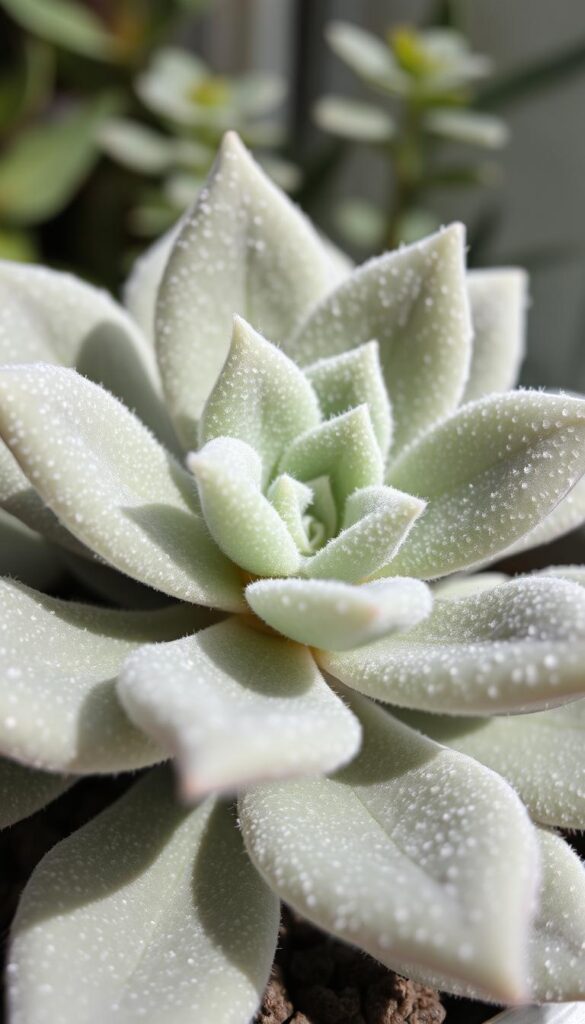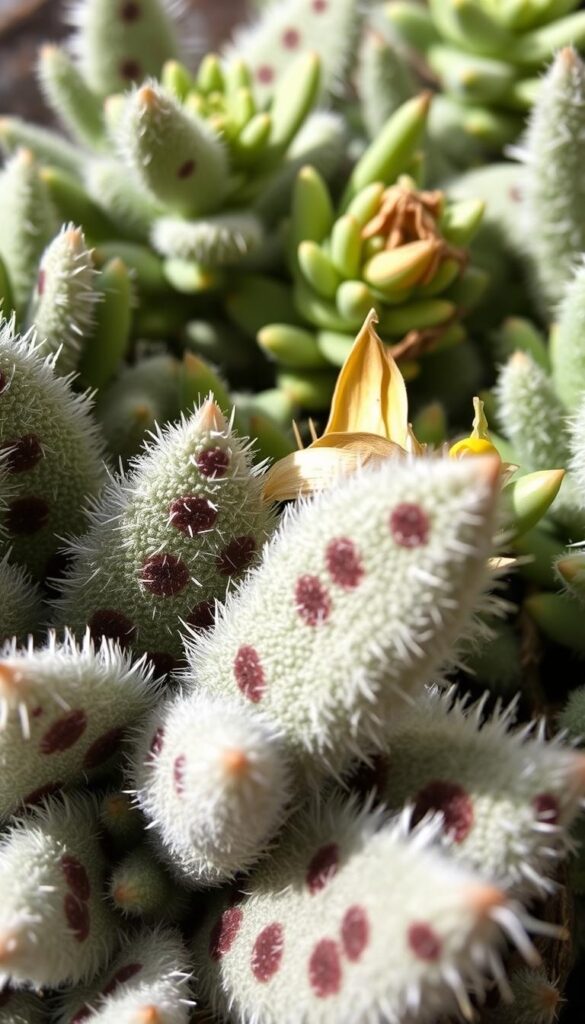If you’re looking for a unique and easy-to-care-for houseplant, the Panda Plant (Kalanchoe tomentosa) is an excellent choice. This charming succulent, native to Madagascar, is perfect for beginners and seasoned plant enthusiasts alike. Its thick, fuzzy leaves store water, making it forgiving if you forget to water it from time to time.
The Panda Plant is known for its velvety leaves and rosette growth habit, giving it a distinctive appearance that adds character to any room. It’s a great option for indoor spaces, as it rarely flowers indoors and maintains its decorative appeal year-round. Plus, it’s pet-friendly, making it a wonderful addition to family homes.
One of the best things about the Panda Plant is its adaptability. It thrives in bright, indirect light and average room temperatures, making it easy to find the perfect spot indoors. Whether you’re starting your plant journey or expanding your collection, this succulent is sure to delight with its low-maintenance requirements and charming appearance.
In this guide, I’ll walk you through everything you need to know about planting, propagating, and caring for your Panda Plant. By the end, you’ll be equipped with the knowledge to keep your succulent happy and thriving.
Origins and Unique Characteristics of the Panda Plant
Kalanchoe tomentosa, affectionately known as the Panda Plant, hails from the arid landscapes of Madagascar. This resilient succulent belongs to the Crassulaceae family, a group known for its drought-tolerant species. Over time, it has evolved into a hardy plant, perfect for indoor environments.
The Story Behind Kalanchoe tomentosa
The name “tomentosa” comes from Latin, meaning “covered in hairs,” which aptly describes the plant’s fuzzy leaves. These leaves store water, making the Panda Plant forgiving for forgetful waterers. Their velvety texture adds to the plant’s charm, setting it apart from other succulents.
Distinctive Features and Popular Varieties
One standout variety is the ‘Chocolate Soldier,’ named for its distinctive chocolate-brown leaf edges. Other varieties like ‘Nigra’ and ‘Rubra’ offer different edge colorations, adding diversity to this species. The Panda Plant’s rosette arrangement and durability make it a favorite among succulent enthusiasts.
Light exposure can influence the intensity of these colors, with brighter light deepening the hues. This adaptability makes the Panda Plant a versatile choice for various lighting conditions, ensuring it remains a stunning addition to any room.
Planting and Propagating Your Kalanchoe tomentosa
Planting and propagating your Panda Plant is a straightforward process that ensures your succulent thrives. Whether you’re starting from a seedling or propagating a mature plant, the right techniques make all the difference.
Choosing the Right Soil, Pot, and Location
Selecting the right pot and soil is crucial for your Panda Plant’s health. Opt for a pot with excellent drainage to prevent waterlogged soil, which can lead to root rot. A cactus or succulent soil mix is ideal as it promotes proper aeration and drainage. Place your plant in a bright area with indirect light to encourage healthy growth.
Step-by-Step Propagation Techniques
Propagation can be done using leaf cuttings or offshoots. For leaf propagation, choose healthy leaves, allow them to air-dry to form a callus, then plant them in well-draining soil. Water sparingly until roots develop. This method is effective and ensures robust growth.
Timing Your Planting for Optimal Growth
Spring is the best time to plant or propagate your Panda Plant. The warmer temperatures and longer days support root establishment and growth. Ensure the soil is dry before watering to prevent overwatering, which is essential for succulents.
| Factor | Recommendations |
|---|---|
| Soil | Cactus or succulent mix for drainage and aeration |
| Pot | Choose a pot with drainage holes to prevent waterlogging |
| Location | Bright, indirect light for optimal growth |
| Timing | Spring for planting and propagation |

Caring for Your Panda Plant: Light, Water, and Fertilization
Caring for a Panda Plant involves understanding its needs for light, water, and nutrients. This succulent thrives in bright, indirect light, making it perfect for indoor spaces. Proper care ensures your Kalanchoe tomentosa stays healthy and vibrant.
Finding the Perfect Lighting Conditions
Panda Plants love bright, indirect light. Direct sunlight can cause leaf burn, so placing them near an east- or west-facing window is ideal. Avoid north-facing windows, as they may not receive enough light. The fuzzy leaves will stay soft and healthy in the right light conditions.
Watering Dos and Don’ts for Healthy Growth
Water your Panda Plant only when the soil feels dry to the touch. Overwatering can lead to root rot, so drainage is key. Use a well-draining soil mix and a pot with drainage holes to prevent waterlogging. Water sparingly, allowing the soil to dry out completely between waterings.
| Factor | Recommendations |
|---|---|
| Light | Bright, indirect light |
| Water | Water when soil is dry |
| Soil | Use a well-draining mix |
| Fertilization | Fertilize once during the growing season |
Fertilizing your Panda Plant should be minimal. Use a gentle liquid fertilizer during the growing season (spring to summer) to promote healthy growth. Avoid wetting the leaves to prevent fungus and mildew. With proper care, your Panda Plant will remain a charming, low-maintenance addition to your home.
Common Issues and Quick Fixes for Kalanchoe tomentosa
Like any succulent, the Panda Plant can face certain challenges. Overwatering and pests are the most common issues, but with the right care, these problems are easy to fix.
Preventing Overwatering and Root Rot
Overwatering is the top cause of root rot in Panda Plants. If the leaves turn yellow or feel mushy, it’s a sign of too much water. To fix this, stop watering until the soil is dry. Repotting the plant in fresh, well-draining soil can also help.
Managing Pests and Environmental Stress
Mealybugs and spider mites can infest your Panda Plant. Use rubbing alcohol on a cotton swab to gently remove these pests. Ensure good air circulation and avoid high humidity to keep your succulent healthy.
| Issue | Signs | Solution |
|---|---|---|
| Overwatering | Yellow or mushy leaves | Stop watering until soil is dry; repot if necessary |
| Root Rot | Soft, rotting stems | Remove affected roots; repot in fresh soil |
| Mealybugs | White, cottony patches | Apply rubbing alcohol with a cotton swab |
| Spider Mites | Fine webbing on leaves | Isolate plant; treat with insecticidal soap |

Regular checks and proper care can prevent most issues. Keep your Panda Plant in well-draining soil and ensure good air circulation to avoid pests and root rot. With these tips, your succulent will stay healthy and thrive.
Final Reflections on My Panda Plant Experience
My journey with the Panda Plant has been a rewarding adventure, teaching me the value of patience and proper care. This succulent, with its fuzzy leaves and charming appearance, has brought joy to my home. I’ve learned to balance its care with its natural growth cycle, ensuring it thrives indoors.
Over the years, I’ve discovered the importance of bright, indirect light and well-draining soil. Watering sparingly and providing good air circulation have been key to its health. Although it’s low-maintenance, consistent attention is crucial to prevent issues like root rot or pests.
Keeping it indoors during colder months and ensuring it gets enough warmth in summer has been essential. It’s a pet-friendly addition, but I remind others to keep it out of reach. My experience shows that while it’s slow-growing, the satisfaction of watching it flourish is well worth the effort.
To fellow enthusiasts, I recommend staying informed about its needs, especially regarding light and water. By following these tips, you’ll enjoy the unique beauty of the Panda Plant for years to come.
